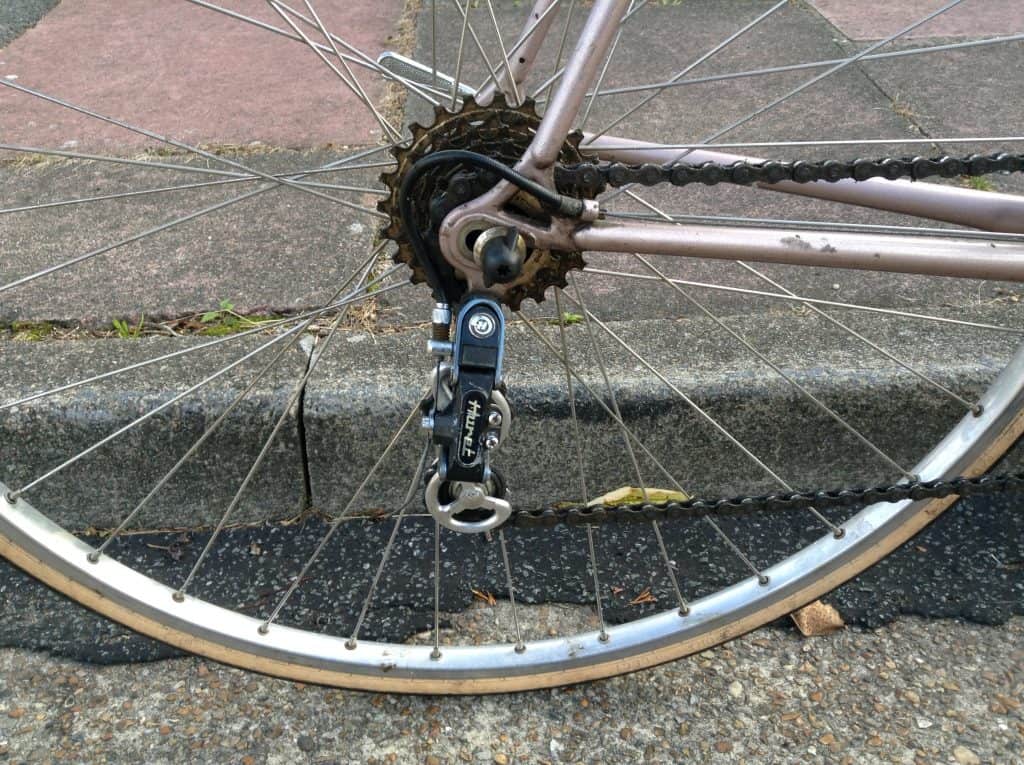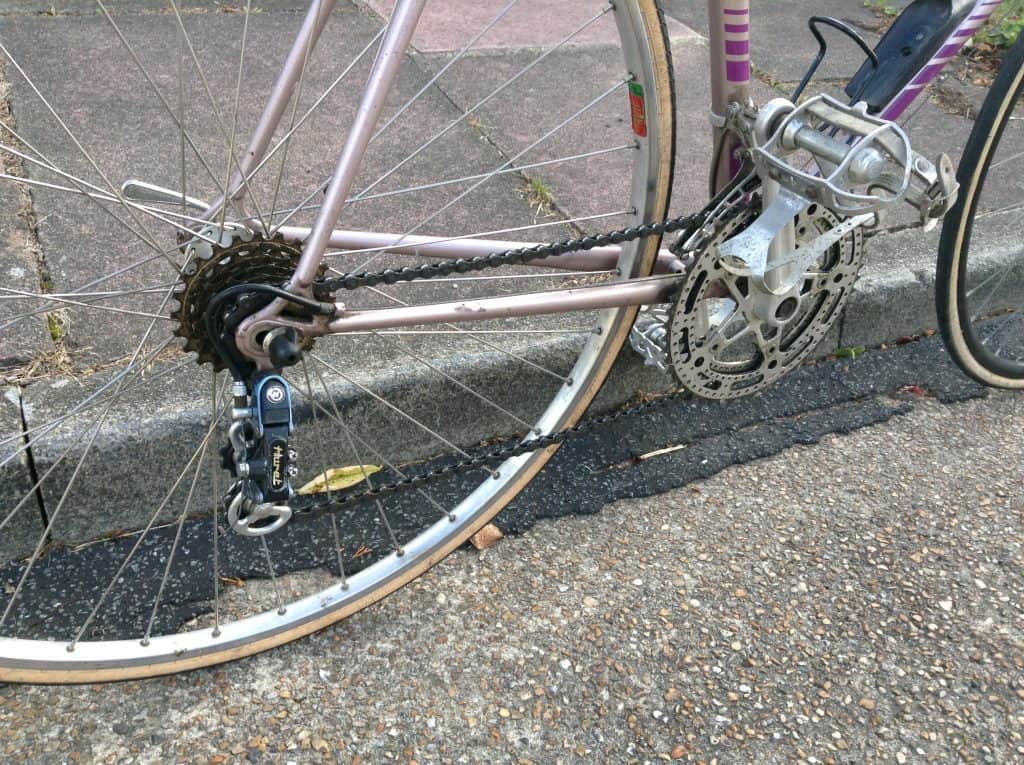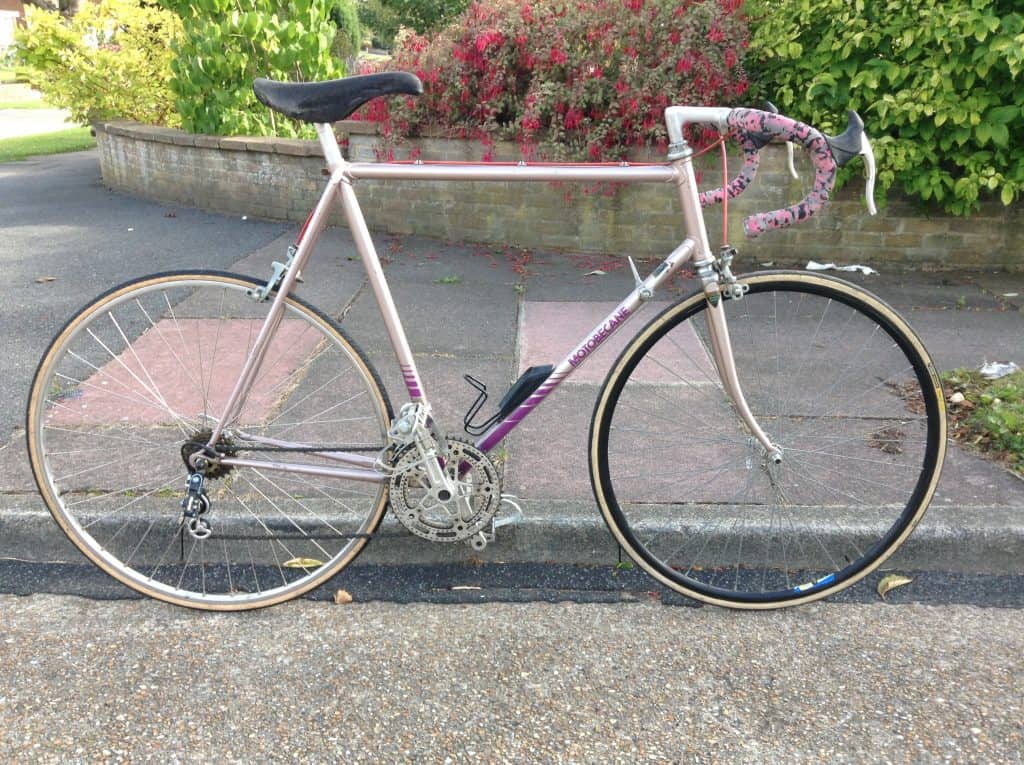Huret’s Best?
Huret made some beautiful components in the steel bike era, and the Success was one of the later models of gear sets. It was first released in 1975 and they continued making this successful model into the mid 1980’s. These days Huret’s Jubilee gets the most admiration, but the Success, though not as beautiful, was just as light and tougher than the delicate crown jewel of the French marque. Admittedly, the rear derailleur has its fair share of plastic, but it doesn’t spoil what is a great derailleur. I decided to do a road test of the Success, just to see how the derailleurs and shifters were holding up after decades of use, and to see how well they performed on a 1982 Motobecane C5.
The Test
The rear derailleur, with its titanium body ( but not bolts ), weighs just 170 grams. Now let’s put this into perspective; this vintage derailleur made in 1981, is therefore just 4 grams heavier than a 2009 Dura Ace 7800, and lighter than a 2010 Campagnolo Record. That’s quite amazing, when you think that it was first made in 1975! The set up it was going to face would be quite tough for it, though; the rear wheel on this Motobecane had a 7 speed freewheel, 13 – 24 teeth, on an old chain and cable. The Success came with two holes to adjust the spring positions: the top hole is stamped 24 and the bottom 28, providing its owner the ability to move the spring to adapt for a larger freewheel. In this case, the spring was set in the upper hole, for smaller 24 teeth maximum freewheel. The font derailleur and shifters had also not been used for a very long time.
How they Performed
I first installed the original 5 speed freewheel of the Motobecane, a “corn cob” from 11 – 18 teeth. The long abandoned derailleurs sprung into action really well, the rear moving across the cogs with good speed and accuracy. There was no hesitation nor lag, the speed of the change was as efficient and as fast as a 1985 Shimano SIS derailleur I had been testing previously. Mechanically it felt as smooth as a Simplex SLJ and a Suntour Cyclone 3700, two of the best rear derailleurs of the 1980’s. The front derailleur, though in need of an overhaul, moved the chain onto the big ring of the crank with the barest of efforts. All gears were reached without strain, in the best way which vintage bikes run with such simple efficiency. Swapping the 5 speed rear wheel for a 7 speed, however, immediately caused a chainline problem.
Tackling the 7 Speed
The rear derailleur’s mounting bolt, which sits on the inside of the rear dropout, provided the first problem fitting the 7 speed rear wheel. It was rubbing on the chain when the lowest gear was selected, meaning that there wasn’t enough space between freewheel and dropout. The nut is also thicker than the Shimano derailleur’s thin version which I had on there. So obviously in 1st gear, there was friction and this gear was unusable. Nevertheless, the derailleur handled the other 6 cogs well, and when the front derailleur moved the chain onto the big 53 ring of the crank, the derailleur pushed through all the cogs until it got to the large 24 tooth; here, it brawled and fought in a battle with itself, like some animal stuck in a trap. It couldn’t make the jump onto the 24, and at that point the snarl of the chain and derailleur made me stop the bike.
Conclusions
With the 24 tooth challenge, which was the limit of the derailleur’s setup, the Success reached its full potential and couldn’t quite handle the 7 speed rear wheel. Probably, with the spring moved to the 28 hole limit, it would have moved onto the cog. However, the problem with the chainline on the first gear would have required some spacers to be installed on the hub. I think the Success is much more comfortable and designed to be running on a 5/6 speed freewheel and hub, which it does superbly. Light, lean and mechanically nimble, it’s a superb vintage derailleur, worthy of a greater reputation as its better than a Campagnolo Super Record. The rear derailleur won’t rust, the front looks superb with its black and gold design, and the drilled shifters are a perfect match.






la marque française Huret à assez vite produit un boulon de dérailleur arr à contre -écrou noyé (ou tête affleurante) qui permettait l’entrée d’une composition roue-libre 6 vitesses dans un cadre 122mms d’empattement.
le système 7 vitesses nécessite un empattement 126mms.
ce dérailleur fonctionne en effet très bien en toutes circonstances double plateaux avec la chape courte et triple à condition d’utiliser la chape longue, mais je ne connais pas ses capacités précises . ces infos seraient très interessantes
Huret a vite conçu et produit un boulon de fixation au cadre de ce type de dérailleur, boulon a écrou à tête noyé ou affleurante permettant l’entrée dans le cadre 122mms d’une roue-libre 6 vitesses.
le système 7 v nécessite un empattement 126mms.
ce dérailleur à chape courte fonctionne très bien en double plateau et offre une grande plage de braquets ; dommage ,je n’en connais pas les capacités précises techniques.
pour le triple plateaux il faut utiliser évidemment une chape longue, le dérailleur couvre aussi alors une grande plage de braquets.
tous ces anciens systèmes de transmission n’ont trouvé leurs limites que dans l’arrivée des systèmes nippons indexées; manettes au cadre 7v à friction ils sont toujours imbattables coté poids mais aussi cotés précision pour peu que l’on sache bien les manipuler
Merci pour l’information, c’etait très intéressant. Je suis en accord avec vous sur les manettes, mais ils ne sont pas facile à utiliser pour tout le monde.